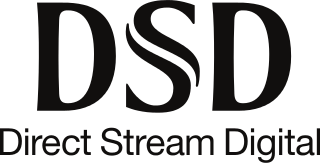Related Research Articles

Digital audio is a representation of sound recorded in, or converted into, digital form. In digital audio, the sound wave of the audio signal is typically encoded as numerical samples in a continuous sequence. For example, in CD audio, samples are taken 44,100 times per second, each with 16-bit sample depth. Digital audio is also the name for the entire technology of sound recording and reproduction using audio signals that have been encoded in digital form. Following significant advances in digital audio technology during the 1970s and 1980s, it gradually replaced analog audio technology in many areas of audio engineering, record production and telecommunications in the 1990s and 2000s.

Digital Audio Tape is a signal recording and playback medium developed by Sony and introduced in 1987. In appearance it is similar to a Compact Cassette, using 3.81 mm / 0.15" magnetic tape enclosed in a protective shell, but is roughly half the size at 73 mm × 54 mm × 10.5 mm. The recording is digital rather than analog. DAT can record at sampling rates equal to, as well as higher and lower than a CD at 16 bits quantization. If a comparable digital source is copied without returning to the analogue domain, then the DAT will produce an exact clone, unlike other digital media such as Digital Compact Cassette or non-Hi-MD MiniDisc, both of which use a lossy data-reduction system.
A hard disk recorder (HDR) is a system that uses a high-capacity hard disk to record digital audio or digital video. Hard disk recording systems represent an alternative to reel-to-reel audio tape recording and video tape recorders, and provide non-linear editing capabilities unavailable using tape recorders. Audio HDR systems, which can be standalone or computer-based, are typically combined with provisions for digital mixing and processing of the audio signal to produce a digital audio workstation (DAW).

Multitrack recording (MTR), also known as multitracking, is a method of sound recording developed in 1955 that allows for the separate recording of multiple sound sources or of sound sources recorded at different times to create a cohesive whole. Multitracking became possible in the mid-1950s when the idea of simultaneously recording different audio channels to separate discrete "tracks" on the same reel-to-reel tape was developed. A "track" was simply a different channel recorded to its own discrete area on the tape whereby their relative sequence of recorded events would be preserved, and playback would be simultaneous or synchronized.

Direct Stream Digital (DSD) is a trademark used by Sony and Philips for their system for digitally encoding audio signals for the Super Audio CD (SACD).

Alesis Digital Audio Tape, commonly referred to as ADAT, is a magnetic tape format used for the recording of eight digital audio tracks onto the same S-VHS tape used by consumer VCRs, and the basis of a series of multitrack recorders by Alesis. Although originally a tape-based format, the term ADAT later also referred to hard disk recorders like the Alesis ADAT HD24. In 2004, recognizing the ADAT for "beginning a revolution of affordable recording tools," it was inducted into the first-ever TEC Awards TECnology Hall of Fame.

In digital recording, an audio or video signal is converted into a stream of discrete numbers representing the changes over time in air pressure for audio, or chroma and luminance values for video. This number stream is saved to a storage device. To play back a digital recording, the numbers are retrieved and converted back into their original analog audio or video forms so that they can be heard or seen.

The 8mm video format refers informally to three related videocassette formats. These are the original Video8 format and its improved successor Hi8, as well as a more recent digital recording format known as Digital8. Their user base consisted mainly of amateur camcorder users, although they also saw important use in the professional television production field.
The Digital Audio Stationary Head or DASH standard is a reel-to-reel, digital audio tape format introduced by Sony in early 1982 for high-quality multitrack studio recording and mastering, as an alternative to analog recording methods. DASH is capable of recording two channels of audio on a quarter-inch tape, and 24 or 48 tracks on 1⁄2-inch-wide (13 mm) tape on open reels of up to 14 inches. The data is recorded on the tape linearly, with a stationary recording head, as opposed to the DAT format, where data is recorded helically with a rotating head, in the same manner as a VCR. The audio data is encoded as linear PCM and boasts strong cyclic redundancy check (CRC) error correction, allowing the tape to be physically edited with a razor blade as analog tape would, e.g. by cutting and splicing, and played back with no loss of signal. In a two-track DASH recorder, the digital data is recorded onto the tape across nine data tracks: eight for the digital audio data and one for the CRC data; there is also provision for two linear analog cue tracks and one additional linear analog track dedicated to recording time code.
TEAC Corporation is a Japanese electronics manufacturer. TEAC was created by the merger of the Tokyo Television Acoustic Company, founded in 1953, and the Tokyo Electro-Acoustic Company, founded in 1956.
TASCAM is the professional audio division of TEAC Corporation, headquartered in Santa Fe Springs, California. TASCAM established the Home Recording phenomenon by creating the "Project Studio" and is credited as the inventor of the Portastudio, the first cassette-based multi-track home studio recorders. TASCAM also introduced the first low-cost mass-produced multitrack recorders with Simul-Sync designed for recording musicians, and manufactured reel-to-reel tape machines and audio mixers for home recordists from the early 1970s through the mid-1990s. Since the early 00's, TASCAM has been an early innovator in the field-recording and audio accompaniment to video with their DR-series recording platforms. TASCAM celebrated its 50th anniversary in 2021.

The TASCAM Portastudio was the first four-track recorder based on a standard compact audio cassette tape. The term portastudio is exclusive to TASCAM, though it is generally used to describe all self-contained cassette-based multitrack recorders dedicated to music production. The Portastudio, and particularly its first iteration, the Teac 144, is credited with launching the home-recording wave, which allowed musicians to cheaply record and produce music at home, and is cited as one of the most significant innovations in music production technology.
Soundstream Inc. was the first United States audiophile digital audio recording company, providing commercial services for recording and computer-based editing.
A transport is a device that handles a particular physical storage medium itself, and extracts or records the information to and from the medium, to an outboard set of processing electronics that the transport is connected to.
The history of sound recording - which has progressed in waves, driven by the invention and commercial introduction of new technologies — can be roughly divided into four main periods:
Foster Denki KK is an electronics company that manufactures loudspeakers and audio equipment for other companies or sells them under the trade name Fostex. It is traded on the Tokyo Stock Exchange.
Mitsubishi's ProDigi was a professional audio, reel-to-reel, digital audio tape format with a stationary head position, similar to Sony's Digital Audio Stationary Head, which competed against ProDigi when the format was available in the mid-1980s through the early 1990s. Audio was digitally recorded linearly on the tape and is guarded by a powerful error correction scheme of cyclic redundancy checks to ensure integrity of the signal even if data is lost during playback. Prodigi recorders were available in 2-track variations, which used 1/4" tape; 32-track variations, which used 1" tape, and a 16-track version using 1/2" tape. All of the machines require the use of metal particle tape.
The Tascam Digital Interface (TDIF) is a proprietary format connector defined by TASCAM that is unbalanced and uses a 25-pin D-sub cable to transmit and/or receive up to eight channels of digital audio between compatible devices. Unlike the ADAT lightpipe connection, TDIF uses a bidirectional connection, meaning that only one cable is required to connect the eight ins and outs of one device or another.

Multitrack recording of sound is the process in which sound and other electro-acoustic signals are captured on a recording medium such as magnetic tape, which is divided into two or more audio tracks that run parallel with each other. Because they are carried on the same medium, the tracks stay in perfect synchronization, while allowing multiple sound sources to be recorded at different times.

Remote recording, also known as location recording, is the act of making a high-quality complex audio recording of a live concert performance, or any other location recording that uses multitrack recording techniques outside of a recording studio. The multitrack recording is then carefully mixed, and the finished result is called a remote recording or a live album. This is in contrast to a field recording which uses few microphones, recorded onto the same number of channels as the intended product. Remote recording is not the same as remote broadcast for which multiple microphones are mixed live and broadcast during the performance, typically to stereo. Remote recording and remote broadcast may be carried out simultaneously by the same crew using the same microphones.
References
- ↑ Perry, Megan (2004). Wired: musicians' home studios: tools & techniques of the musical mavericks. Hal Leonard Corporation. p. 131. ISBN 0-87930-794-3 . Retrieved 2011-04-12.
- ↑ The Definitive Guide to The Tascam DA-88 and DTRS-Format Recorders, Chapter 1: Equipment Overview. Retrieved on 2012-12-01.
- ↑ Summers, Jodi (2004). Making and marketing music: the musician's guide to financing, distributing, and promoting albums (2nd ed.). Allworth Communications, Inc. ISBN 1-58115-387-2 . Retrieved 2011-04-12.
- ↑ Archived 2020-06-03 at the Wayback Machine The Definitive Guide to The Tascam DA-88 and DTRS-Format Recorders. Retrieved on 2012-05-10.
- ↑ Alberts, Randy (2003). TASCAM: 30 years of recording evolution. Recording and Audio Technology Series. Hal Leonard Corporation. ISBN 0-634-01156-1 . Retrieved 2011-04-12.
- ↑ Verna, Paul (September 11, 1999). "Tascam Marks 25 Years of Audio Innovation". Billboard. Retrieved 2011-04-12.